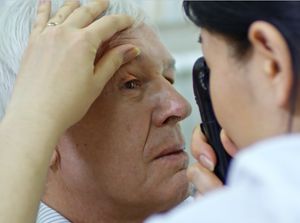Diabetic Eye Disease
Diabetic eye disease refers to a group of eye problems that people with diabetes may face. All forms of diabetic eye disease have the potential to cause severe vision loss and blindness. Additionally, because diabetic eye disease often goes unnoticed until vision loss occurs, people with diabetes should get a comprehensive dilated eye exam at least once a year as recommended by the American Diabetes Association, The Centers For Disease Control, Medicare and every major insurance company in the country.
People with diabetes are at risk for:
- Diabetic Retinopathy
- Diabetic Macular Edema (DME)
- Cataract
- Glaucoma
Even if patients are having their eyes checked by the primary care physician monitoring their diabetes, an annual dilated eye exam should be performed by an Ophthalmologist who treats patients with diabetes. Unlike Primary Care Physicians, Ophthalmologists have specialized equipment that can better assist them in a detailed evaluation of the entire eye. This is necessary to ensure the earliest possible diagnosis and treatment, which will help to preserve the visual acuity of every patient with diabetes.
Why is the annual eye exam so important?
- Damage to the eye can occur before pain, vision blurring, or other symptoms.
- Early detection and treatment can reduce the risk of blindness by 95 percent.
- When caught early, excellent treatments for diabetic eye disease are available.
- If diabetic changes are found in the eye, it is likely changes are happening throughout the body where they are more difficult to detect.
Controlling diabetes by taking medications as prescribed, staying physically active, and maintaining a healthy diet can prevent or delay vision loss. Early detection, timely treatment, and appropriate follow-up care of diabetic eye disease can protect against vision loss.

View Video: Diabetes Eye Exam
Diabetic Retinopathy
Diabetic Retinopathy involves changes to retinal blood vessels that can cause them to bleed or leak fluid, distorting vision. Diabetic retinopathy is the most common cause of vision loss among people with diabetes and a leading cause of blindness among working-age adults.
Diabetic Macular Edema (DME)
Diabetic Macular Edema (DME) is a consequence of diabetic retinopathy that causes swelling in the area of the retina called the macula. The macula is important for the sharp, straight-ahead vision that is used for reading, recognizing faces, and driving. DME is the most common cause of vision loss among people with diabetic retinopathy. About half of all people with diabetic retinopathy will develop DME. Although it is more likely to occur as diabetic retinopathy worsens, DME can happen at any stage of the disease.
Cataract
A cataract is a clouding of the normally clear lens of the eye. Adults with diabetes are 2-5 times more likely than those without diabetes to develop cataract. Cataract also tends to develop at an earlier age in people with diabetes.
Glaucoma
Glaucoma is a group of diseases that damage the eye’s optic nerve—the bundle of nerve fibers that connects the eye to the brain. Some types of glaucoma are associated with elevated pressure inside the eye. In adults, diabetes nearly doubles the risk of glaucoma
Summary
The importance of annual dilated exams by an Ophthalmologist cannot be understated. We’re talking about your eyes which are critically important to the successful and happy interaction with the world around you. Don’t wait. Don’t assume that because you diligently manager your blood glucose that your eyes will not be affected. If you’ve been diagnosed with diabetes, an annual dilated eye exam is one of the most important things you can do for yourself.
